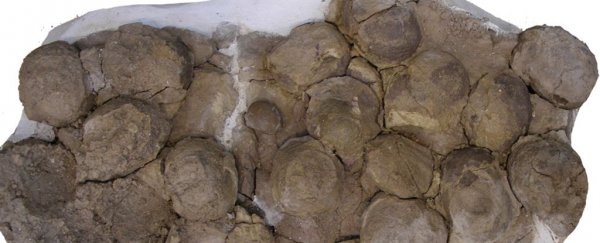A Jurassic graveyard in Patagonia, Argentina, holds more than 100 fossilized eggs and the bones of 80 Mussaurus patagonicus dinosaurs ranging in age from hatchling to adult. The trove of dinosaur remains suggests that these paleo-beasts lived in herds as early as 192 million years ago, a new study finds.
The finding is the oldest evidence on record that dinosaurs lived in herds and suggests that dinosaurs displayed socially complex, gregarious behavior 40 million years earlier than previously thought, the researchers said.
The graveyard also shows that the herd had internal structure; for instance, young dinosaurs hung out (and died) together in cliques.
It's rare to find signs of behavior preserved in dinosaur bones, but "now we have evidence of a complex social behavior structure within the herd," said study lead researcher Diego Pol, a paleontologist at the Museo Paleontológico Egidio Feruglio and the National Scientific and Technical Research Council in Argentina (CONICET).
 Artistic reconstruction of a nest of Mussaurus patagonicus with hatchlings and an adult parent. (Jorge Gonzalez)
Artistic reconstruction of a nest of Mussaurus patagonicus with hatchlings and an adult parent. (Jorge Gonzalez)
"I would say this is one of the top paleontological discoveries of the year," said Michael D'Emic, an associate professor in the Department of Biology at Adelphi University in New York, who was not involved with the study. "It is so exciting to have so many individuals of one fossil species, from embryos to adults."
Related: Photos: School-bus-size dinosaur discovered in Egypt
Since 2002, Pol and his colleagues have spent part of their field seasons excavating a relatively small outcrop, about 0.3 square miles (1 square kilometer), at the Laguna Colorada Formation in southern Patagonia.
The formation is known for containing the fossils of M. patagonicus, which, based on tiny fossilized hatchling specimens found in 1979, was inappropriately given a scientific name that means "mouse lizard".
Over the years, Pol's team discovered more than 100 eggs and the fossils of dozens of new M. patagonicus individuals. The specimens include dinosaurs from six different life stages, ranging from embryos to adults.
Previous studies have revealed that M. patagonicus laid eggs with soft, leathery shells and likely walked on all fours as infants, transitioning to bipedal walking shortly after their first birthday.
But now, Pol and his colleagues have enough evidence to show that this sauropodomorph – a group of herbivorous, long-necked dinosaurs – lived in herds.
His team hypothesizes that herd living began as sauropodomorphs transitioned from small to colossal dinosaurs. For most of the Triassic period (252 million to 201 million years ago) dinosaurs were small, about the size of horses.
But between 227 million and 208 million years ago, sauropodomorphs got big, changing their body size by two orders of magnitude, the researchers wrote in the study. But they still laid tiny eggs. In the case of M. patagonicus, hatchlings cracked out of chicken-size eggs and grew to about 3,300 pounds (1,505 kilograms) as adults, or about the weight of a hippo.
In other words, M. patagonicus hatchlings had to grow to enormous sizes in just a few years.
"This is a time when they need to eat quite a lot to grow, but they don't have the size to be able to defend themselves and they don't have the expertise and the knowledge," Pol told Live Science.
"So, living in a herd actually protects you during those very vulnerable, fragile stages of your life."
Nests and cliques
At the site, the paleontologists found eggs arranged in clusters, a clue that M. patagonicus males or females dug holes that females then used as nests. These nests had between eight and 30 eggs, Pol said. X-ray computed tomography (CT) imaging of five of these nests revealed that the eggs were arranged in two to three layers and that they contained embryonic bones of M. patagonicus.
The huge number of egg clusters at the site indicates it was a common breeding ground for the dinosaurs, he noted.
Related: Gallery: Massive new dinosaur discovered in sub-Saharan Africa
The site had other clusters of dinosaurs at different life stages, including a group of 11 juveniles under 1 year old, two adults that were found together and nine nearly-mature adults. Perhaps M. patagonicus lived together in herds, but dinosaurs of different ages tended to hang out together, Pol said.
These dinosaurs likely died because of a drought. "We know this place was seasonal, and there are indications of droughts in the sediment," Pol said. Many of the animals died in a resting pose, meaning they died laying down and then were covered by windblown dust.
It's "extremely rare" to find so many well preserved dinosaurs in one place, D'Emic told Live Science in an email.
"It is even more interesting and important that these animals seemed to live in social groups. People tend to think of extinct groups like these sauropodomorphs as evolutionary 'dead ends,' but that doesn't mean they didn't have advanced behaviors like sociality."
In fact, "sociality may have been important in the evolutionary success of sauropods, the largest animals that ever walked the Earth," D'Emic said.
The study was published online Thursday (Oct. 21) in the journal Scientific Reports.
Related Content:
Photos: Enormous titanosaur invades New York museum
Photos: Giant sauropods plodded along in Scottish lagoon
Photos: Meet Wade, the long-necked dinosaur from Down Under
This article was originally published by Live Science. Read the original article here.
